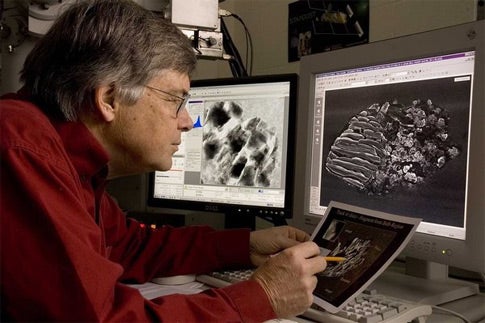In January 2006, NASA’s Stardust spacecraft landed smack in the middle of a Utah mud flat, its heavily-protected container holding thousands of precious particles of Comet Wild 2. The particles were captured in a glassy product called aerogel as the spacecraft encountered the comet beyond the orbit of Mars in January 2004. Now, after 200 scientists have completed their preliminary investigation of the particles, the Stardust team has announced its first batch of findings, which include surprises that will upset the conventional understanding of the early solar system.
Team members, including Don Brownlee of the University of Washington, Michael Zolensky of the Johnson Space Center, and Scott Sandford of the NASA-Ames Research Center, announced the findings on Thursday at the American Geophysical Union meeting in San Francisco.
They characterized the first results as no less than shocking. The astronomers expected to find mostly interstellar grains — tiny, crystalline and noncrystalline specks that stuck together to form the cometary material. They found interstellar grains, but found much larger particles that are made of complex minerals, many of which had been shocked and melted in the distant past, and stuck together like brecciated rocks.
Comets are mostly icy dirtballs, and they are presumed to have formed out in the very coldest part of the solar system. If this is so, how could they contain rock that was obviously superheated? This major puzzle now looms over planetary scientists.
Brownlee introduced some of the most curious specific rocks that stuck in Stardust’s aerogel, one by one. A tiny clump nicknamed Ada is an igneous rock, a silicate containing iron and olivine that formed in a molten environment. Another, called Inti, has a calcium-aluminum inclusion (CAI) reminiscent of those found in primitive meteorites like Allende. How could a CAI, a molten clump of minerals that formed before the Sun, turn up in something that should have come together in an icy deep-freeze?
Another micro-rock called Febo is an iron-magnesium silicate, and one named Sitara contains iron, nickel sulfides, enstatite, and calcium and sodium silicates — the mineral components of rocks. “We’re seeing real rocks in comets,” says Brownlee, sharing his amazement with journalists and fellow scientists. “Yes, comets are made largely of ice, but also from exotic, high-temperature minerals.” This finding will force astronomers to rethink their ideas about the origins of comets, the origin of the solar system, and the way crystalline silicates form around stars.
“We are finding the hottest minerals in the coldest places,” says Brownlee. “The major question is, ‘How did they get there?'” A slew of ideas exists, from so-called X-winds (blasts of outward energy in the early solar system) to turbulent eddies to orbital instabilities to some unknown thing that astronomers can’t yet imagine.
“The biggest early shock for us is that Wild 2 formed from a great range of materials,” adds Zolensky. “There is no evidence of liquid water with this comet, in stark contrast to the earlier results with Tempel 1.” The mixed bag of components brings to Zolensky’s mind the idea of comets acting as a giant vacuum cleaner, sweeping up all sorts of particles. “Maybe comets are as different as individuals,” he suggests.
Many of the particles studied thus far contain organics, stresses Sandford. “They represent a more diverse group of organic compounds than we have seen in extraterrestrial material before,” he says. They are rich in oxygen and nitrogen, and some have a chemical heritage that predates the solar system.
Studying the comet’s organic molecules will shed more light on the possibility that comets salted early Earth with the organic matter needed to initiate life on Earth. “If you need some pixie dust to get life going and it has all these magical organics,” says Brownlee, “it could be very significant. A lot of this stuff got flung all around the early solar system.”
Studies of the many thousands of Wild 2 particles will go on for years, and will undoubtedly revise models of solar system formation. That’s a pretty big first shot out of the box for the Stardust mission.










